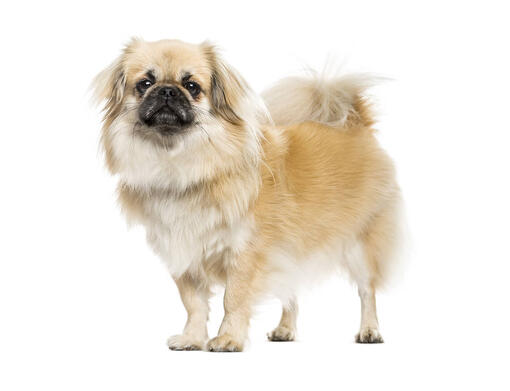
Happy, assertive and highly intelligent, the Tibetan Spaniel has been a prized companion in his native Tibet since 1100 B.C. Small, alert and active, Tibetan Spaniels are outgoing and friendly but may be aloof with strangers. Moderate exercise is suggested, and weekly brushing is needed for the breed’s double coat.
DID YOU KNOW? Tibetan Spaniels were nicknamed “little lions” by Buddhist monks, which gave them great prestige as lions were sacred.
ALSO KNOWN AS: Simkhyi
The need-to-know
- Dog suitable for non-experienced owners
- Basic training required
- Enjoys gentle walks
- Enjoys walking half an hour a day
- Small dog
- Some drool
- Requires grooming every other day
- Non hypoallergenic breed
- Chatty and vocal dog
- Guard dog. Barks and alerts
- Great with other pets
- May require training to live with kids
Personality

Alert and active, the Tibetan Spaniel may be reserved with strangers, yet completely loyal to family. As a companion breed they do not like to be separated from their owner or family, and this is something they must be trained to cope with and even then something they may always struggle with. They have a natural tendency remains to alert owners to whatever is occurring, and this breed trait should not be ignored as they can be extremely vocal.
History and Origins

Country of Origin: Tibet
Bred in Tibet by the monks to act as watchdogs within the monasteries, the Tibetan Spaniel is a spaniel in name only, they have no genetic link to the gundog spaniels, but most likely took the name as they slightly resemble the toy spaniel types. In their original role as watchdogs, the Tibetan Spaniel would climb walls to seek out high vantage points from which to watch, and bark an alarm should someone approach. This behaviour can still be seen in modern Tibetans, whose owners will frequently find them on worktops, table tops and window sills. No, they cannot levitate, they are just extremely gifted climbers!
Nutrition and Feeding

Small dogs have a fast metabolism, meaning they burn energy at a high rate, although their small stomachs mean that they must eat little and often. Small-breed foods are specifically designed with appropriate levels of key nutrients and smaller kibble sizes to suit smaller mouths. This also encourages chewing and improves digestion.
Exercise

An hour’s exercise per day, as well as some training and games in the form of puzzle solving, clicker training and feeding from food dispensing toys should keep the Tibetan Spaniel busy and satisfied. A secure garden is a must as the Tibbie is an excellent digger!
Other Information

Health and common issues
The most common health problem affecting Tibetan Spaniels is an inherited eye disease and so eye testing prior to breeding is important. The breed club monitor the health of the breed carefully and should be contacted for the most up-to-date information and details of any DNA or additional testing they recommend. Breed Clubs can be found on the Kennel Club website.
Space requirements
The Tibetan Spaniel is not a demanding dog to house, a secure garden is vital and it is worth considering how loud or busy your local area is, as this breed is likely to be overstimulated and stressed by constant noise. As long as this is taken into account, the Tibetan Spaniel will happily live in country or town housing.
Training tibetan spaniel
Easily trained this breed is quick to learn and loves to spend time with their owner, positive reinforcement training will get the best out of this little dog. Although small the Tibetan Spaniel should be capable of a variety of dog activities including tracking, man-trailing and mini agility and it is well worth having a go at some of these activities to keep their minds occupied.
Best family dog breeds
Gentle and kind, the Tibetan Spaniel can make an excellent family pet. Caution is advised with very small children as it is very easy for them to mistake small fluffy breeds for toys. Not ideal for the very busy family who have long periods of absence from the home. While many dogs are traditionally thought of as being good with children, all dogs and children need to be taught to get on with and respect each other, and be safe together. Even so, dogs and young children should never be left alone together and adults should supervise all interactions between them.
Did you know?
- Tibetan Spaniels, or at least dogs that look very like them, appear in art that dates to 1100BC – this makes the breed around 3000 years old. It is possible they are the ancestors of the Pekingese and the Lhasa Apso.
- They were once referred to as ‘little lions’ which was a great honour as lions are sacred in Buddhism. In Tibet they’re called ‘Simkhyi’, meaning ‘housedog’, ‘room dog’ or ‘bedroom dog’. Tibetan Spaniels were only ever gifted and never sold, most often to leaders in China or other Buddhist countries. It’s said that this breed helps Lamas with spiritual practices and will often sit next to them or on their lap during meditation.